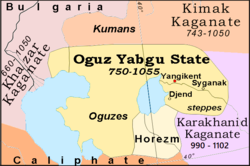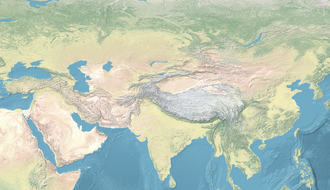Early history
The first reference to the Oghuz State is by the Arab geographer Yaqubi, who mentioned the Oghuz's wars against the Toquz Oghuz, Kimeks, and Karluks; another geographer, Ibn al-Faqih, reported that the Oghuzes along with the Kimeks and Toguz Oghuzes were the "kings" (malik), and were revered among the Turks. [3] In Zhetysu the old Oghuz capital was Guziya.
The Chinese sources, dated to the 7th and 8th centuries, located the 姑蘇 Gūsū (a Western Turkic tribe not belonging to the "Ten Arrows" Union [4] [5] [6] ) consistently in the vicinity of Issyk Kul – Talas; Yury Zuev (1960) links these Gusu to the Oghuz Turks. [7] The center of the Oghuz confederation shifted from the Issyk Kul area to the lower course of the Syr Darya under pressure of the refugees of the Sary Turgesh tribe. [8] Zuev also notes two parallel passages: one from Venus' Secret Classic (Taibo Yinjing 太白陰經) which mentioned the 三屈 "Three Qu" (< MC *k(h)ɨut̚) [a] , [9] and the other from al-Masʻudi's Meadows of Gold and Mines of Gems , which mentioned the three hordes of the Turkic Ġuz. [10]
Despite the similarity in name, Golden contends that the Toquz Oghuz (Chinese: 九姓 Jĭu Xìng "Nine Surnames"), from whom emerged the Uyghurs, were not the same people as the Oghuz who founded the Oghuz Yabgu state in Transoxiana. [11] because Istakhri and Muhammad ibn Muhmad al-Tusi kept the Toquz Oghuz and Oghuz distinct [12] and Ibn al-Faqih mentioned "the infidel Turk-Oghuz, the Toquz-Oghuz, and the Qarluq" [13] Even so, Golden notes the confusion in Latter Göktürks and Uyghurs, where Oghuz apparently referred to Toquz Oghuz or another tribal grouping, who were also named Oghuz without a prefixed numeral; this confusion is also reflected in al-Marwazi, who listed 12 Oghuz tribes, who were ruled by a "Toquz Khaqan" and some of whom were Toquz-Oghuz, on the border of Transoxiana and Khwarazm. At most, the Oghuz were possibly led by a core group of Toquz Oghuz clans or tribes. [14]
In 766, after Karluks overran the Türgesh Khaganate in Zhetysu (southeastern modern Kazakhstan), Karluk tribes formed a Khanate centered there under the rule of a Yabgu, and they occupied and transferred their capital to Suyab. By that time the bulk of the Uch-Karluk (Three Karluks) confederation had left the Altai, and the supremacy in Zhetysu passed to the Karluk tribes. After the Oghuz confederation lost a struggle with the Karluks for leadership in the Turgesh Kaganate, a significant part of Zhetysu Oghuzes migrated to the Karatau Mountains foothills and the valley of the Chu River in the Issyk Kul basin.
At the beginning of the 9th century the Oghuz confederation, in alliance with Karluks and Kimaks destroyed the Kangar Union and captured the lower course of the Syr Darya river and the Aral steppes, displacing the Kangars and Pechenegs. The nomadic tribes of the Syr Darya Kangars were forced to join the Oghuzes, and a part of them migrated to the west to the northern Black Sea region. The Oghuzes moved their capital to Yangikent and became known as Oghuz Yabgu State.
The state was founded in Eni-Kent which was an Oghuz yayla (summer village). Oghuz il extended from "Issyk Kul and Almalyk, in the south, to Sairam, in the west, to the city of Yangikent, which stands at the mouth of the river Syr (Syr-darya), and to the Kara-Kum (desert)". [15] The capital of the Oghuz il was variously spelt Eni-Kent, Yangikent, Djanikand, Yenikent, Yanikand, all meaning New City, and also in Arabic literature al-Kariya al-Hadisa and in Persian literature Deh-i Hay; presently it is a Central Asian ghost town Jankent.
The state was ruled by the leader of the Oghuz Turks with the title Yabgu, which is similar to other Turkic ruling titles such as Khan and Kagan/Hakan, but initially with a status below Khagan. The army was commanded by Subaşı, "sü" meaning "army" (possibly from Late Old Chinese 戍 śwò "frontier guard") [16] and "başı" "head > ruler".
Political history
The Oghuz Yabgus and contemporary Asian polities circa 1000.
The Oghuz State played an important role in the military and political history of Eurasia.
In 965 the Oghuz State allied with Kievan Rus in a war against the Khazar Kaganate. In 985 the alliance with Kievan Rus defeated Volga Bulgaria, which increased the political power of the Oghuz State.
At the turn of the 10th–11th centuries, popular uprisings broke out against excessive taxation in the state. The revolts became especially strong in the second half of the 10th century, during the rule of Ali Yabgu. The split between the ruling Oghuzes and Seljuk branch of Oghuzes turned out to be detrimental to the state. The upheaval was used by the Seljuk branch, who led an uprising and took Jend, but soon they were forced to leave the Jend area.
During the reign of the last Oghuz Yabgu Shahmalik the state rebounded. In 1041 Shahmalik Yabgu conquered Khorezm from the Ghaznavids, but two years later he was captured by the Seljuk forces and executed. Shahmalik Yabgu was the last ruler of the Oghuz State.
Internal turmoil and conflict with the Seljuks weakened the Oghuz State. The weakened state fell under attacks by the Kipchak tribes from the Kimak Kaganate. Under the pressure of the Kipchaks, the two branches of the Oghuz people split, a significant part of the Oghuzes went to Eastern Europe, and the Seljuk Oghuzes left toward Asia Minor. Another part of the Oghuzes fell under the rule of the Karahanids and Seljuk rulers of Khorasan. The remnants of those Oghuz defeated by the Kipchaks subsequently dissolved among the Turkic-speaking tribes of Dasht-e-Kipchak. The Oghuz tribes contributed to the formation of many of today's Turkic peoples.
In the 11th century, Oghuz migration to Persia and the Near East began. The movement was led by the head of the Kınık tribe Tughril and Chaghri Beg, the grandchildren of Seljuk. This migrating group became, in time, the Seljuk Empire. In 1025 a part of the Seljuks settled in the territory of the modern Turkmenistan, centered on the city of Nysa. In 1034–1035, they were joined by Togrul bek's subjects. In 1038–1040, the Seljuks fought against Ghaznavids and captured Nishapur. Subsequently, they were able to create a huge state, which consisted of Asia Minor, Persia, and parts of the Caucasus and Central Asia.
The Oghuz il state existed for three centuries. Another Turkic group, Kipchaks and Kimeks of the Kimek Kaganate, ended the state by the 12th century. By that time, Selçuk Bey and his Kınık (tribe) headed to Persia to found their own Muslim state, which in the future would become the Great Seljuq Empire, and a part of the state population moved eastward to the N.Pontic areas.



